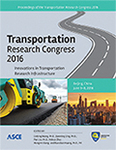Transportation Research Congress 2016
Study of the Formation and Supporting Principle of Filter Cake in Slurry Shield Tunneling by Particle Flow Code
Publication: Transportation Research Congress 2016: Innovations in Transportation Research Infrastructure
ABSTRACT
The formation process of filter cake in slurry shield tunneling was simulated by particle flow code in 3 dimensions (PFC3D), and the supporting principle of filter cake for maintaining the stability of excavation face is discussed. The simulation results show that the formation of filter cake is mainly depended on the particle size distribution of slurry and the pore sizes of stratum. The well graded slurry particles can form more compact filter cake on the excavation face than the poorly graded slurry particles. The more compact filter cake can be formed on the surface of stratum with smaller pore sizes. Moreover, the thickness of filter cake decreases with the increase of pressure difference between slurry and stratum. The supporting principle of filter cake is that the sum of driving force applied by the water to the filter cake, which containing the force applied to filter cake particles by the pressure gradient and the interaction force between filter cake particles and water, provide the horizontal effective stress to balance the horizontal earth pressure in the ground. Therefore, the more compact the formed filter cake, the larger the induced pressure gradient in the filter cake, and then the bigger the resulted horizontal effective stress in the stratum for maintaining the stability of excavation face.
Get full access to this article
View all available purchase options and get full access to this chapter.
ACKNOWLEDGMENTS
The authors would like to acknowledge the financial support of the National Program on Key Basic Research Project of China (2015CB057803), the National Natural Science Foundation of China (51509181), the Tianjin Research Program of Application Foundation and Advanced Technology (15JCQNJC43800) and the Fundamental Research Funds for the Central Universities (2016B01214).
REFERENCES
Bai, Y., Kong, X. P., and Liao, S. M. (2010). “Research on dynamic formation mechanism of slurry membrane for slurry shield.” Rock and Soil Mechanics, 31(Suppl. 2), 19-24 (in Chinese).
Bouillard, J. X., Lyczkowski, R. W., and Gidasow, D. (1989). “Porosity distributions in a fluidized bed with an immersed obstacle.” AICHE Journal, 35(6), 908-922.
Fritz, P. (2007). “Additives for slurry shields in highly permeable ground.” Rock Mechanics and Rock Engineering, 40(1), 81-95.
Han, X. R., Zhu, W., Liu, Q. W., Zhong, X. C., and Min, F. L. (2008). “Influence of slurry property on filter cake quality on working face of slurry shield.” Rock Soil Mech., 29(Suppl. 1), 288-292 (in Chinese).
Itasca Consulting Group, Inc. (2005). “Section2 in Optional Features: Fixed coarse-grid fluid scheme.” PFC3D (Particle Flow Code in 3 Dimensions) version 3.1, Minneapolis, Minnesota, 2.1-2.53 in Optional Features.
Liu, C., Sun, J. Zhao, Z. F., and Zhao, L. Z. (2013). “Two-dimensional theoretical analysis of slurry membrane formation process in slurry shield.” Rock and Soil Mechanics, 34(6), 1593-1597 (in Chinese).
Min, F. L., Zhu, W., and Han, X. R. (2013a). “Filter cake formation for slurry shield tunneling in highly permeable sand.” Tunnelling and Underground Space Technology, 38, 423-430.
Min, F. L., Zhu, W., Han, X. R. and Zhong, X. C. (2010). “The effect of clay content on filter cake formation in highly permeable gravel.” Geotech. Spec. Publ., 204 GSP, 210-215.
Min, F. L., Zhu, W., Wei, D. W. and Xia, S. Q. (2013b). “Change of pore water pressure in soil as filter cakes formed on excavation face in slurry shield.” Chinese Journal of Geotechnical Engineering, 35(4), 722-727 (in Chinese).
Patanker, S. V. (1980). Numerical Heat Transfer and Fluid Flow, Hemisphere Publishing.
Watanabe, T., and Yamazaki, H. (1981). “Giant size slurry shield is a success in Tokyo.” Tunnels and Tunnelling, 13(1–2), 13-17.
Zhang, F. X., Zhu, H. H., and Fu, D. M. (2004). Shield tunnel, People’s Communication Press, Beijing, 178-220 (in Chinese).
Information & Authors
Information
Published In
Transportation Research Congress 2016: Innovations in Transportation Research Infrastructure
Pages: 648 - 661
Editors: Linbing Wang, Ph.D., Virginia Polytechnic University, Jianming Ling, Ph.D., Tongji University, Pan Liu, Ph.D., Southeast University, Hehua Zhu, Tongji University, Hongren Gong, University of Tennessee Knoxville, and Baoshan Huang, Ph.D., University of Tennessee Knoxville
ISBN (Online): 978-0-7844-8124-0
Copyright
© 2018 American Society of Civil Engineers.
History
Published online: Feb 6, 2018
Authors
Metrics & Citations
Metrics
Citations
Download citation
If you have the appropriate software installed, you can download article citation data to the citation manager of your choice. Simply select your manager software from the list below and click Download.
